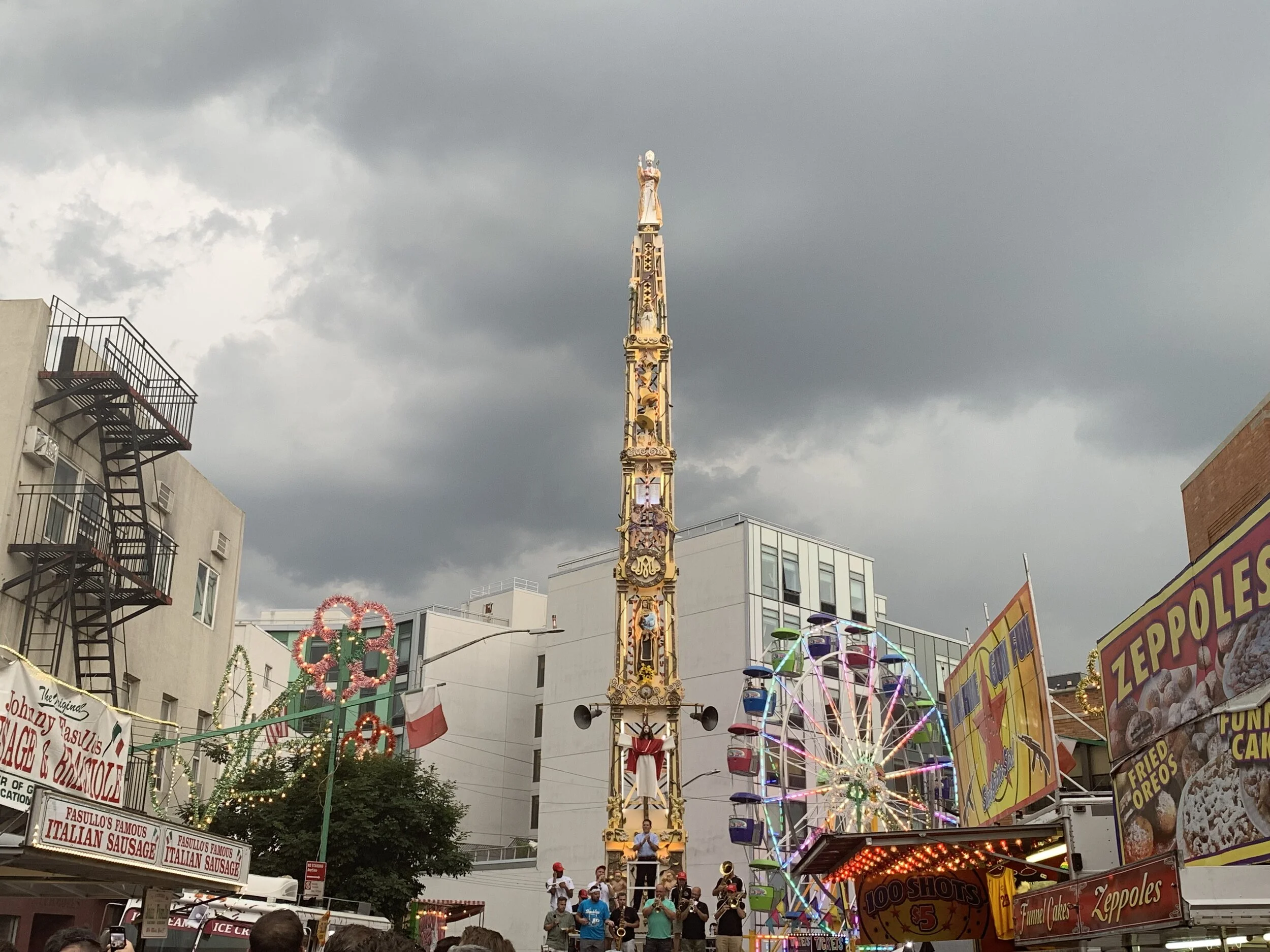Authentic Survivors: Religion and Gentrification in Williamsburg, Brooklyn
By Alyssa Maldonado-Estrada
Every July in Williamsburg, Brooklyn, the Italian American Catholic community celebrates its patron saints in spectacular fashion. During the annual Feast of Our Lady of Mount Carmel and San Paolino di Nola, men in the community perform the Dance of the Giglio, a ritual that has been celebrated in Brooklyn since 1903. Hundreds of men lift the seventy-foot-tall, four-ton tower, decorated with baroque angels, saints, and arches, through the streets in honor of Saint Paulinus (San Paolino), the patron saint of Nola, Italy.
Read MoreThose Who Know Don’t Say: Interview with Garrett Felber
Interviewed by Kenneth M. Donovan
Today on the blog, Kenneth Donovan interviews Garrett Felber about his recently published book Those Who Know Don’t Say: The Nation of Islam, The Black Freedom Struggle, and the Carceral State. Those Who Know, which reevaluates the civil rights activism and legacy of the Nation of Islam, was shortlisted for the 2020 Museum of African American History Stone Book Award.
Read MoreParish History on New York City's Upper West Side
Reviewed by Susie Pak
Thomas J. Shelley has added to his already substantial oeuvre of New York Catholic history with the publication of Upper West Side Catholics: Liberal Catholicism in a Conservative Archdiocese: The Church of the Ascension, New York City, 1895-2020 (New York: Empire State Editions, 2020).[1] His deep and broad understanding of New York’s Catholic institutions provides the context for his study of the Church of the Ascension, which was founded in 1895 on the Upper West Side. While his history of Ascension starts from its founding, Shelley’s book offers an extended view of the neighborhood during the 1960s and 1970s, a period when demographic transition overlapped with economic decline and produced immense political conflicts that destabilized New York’s institutions, including the Catholic Church.
Read MoreIsland Gospel: Pentecostal Music and Identity in Jamaica and the United States
Review by Ray Allen
Writing about musical performance during the time of COVID-19 gives me pause, as it does, no doubt, for all of us who revel in live music. Whether we choose to raise our voices in praise of the deities or to drum and dance to the most sensual rhythms, the act of communal music making is, at its core, a celebration of our deepest humanity. Michael Butler’s Island Gospel is a keen reminder of this reality, and leaves us longing for the day when we can again gather in places of worship, dance halls, clubs, concert venues, and street fetes for the simple joy of making music together.
Read MoreThe Gomez Family and Atlantic Patterns in the Development of New York's Jewish Community
By Noah L. Gelfand
On November 1, 1750, Mordecai Gomez, a member of one of North America’s most prominent Jewish mercantile families, died in New York City. According to a notice a few days later in the New-York Gazette, or Weekly Post-Boy, the sixty-two year old Gomez was “esteemed a fair Trader, and charitable to the Poor” who passed away “with an unblemish’d Character;” and who would be “deservedly lamented” by his large family and all his acquaintances.
Read MoreHeaven's Wrath: Interview with Danny Noorlander
Interviewed by Deborah Hamer
Today on the blog Gotham editor Deborah Hamer speaks with Danny Noorlander, associate professor at SUNY-Oneonta, about his new book Heaven’s Wrath: The Protestant Reformation and the Dutch West India Company in the Atlantic World, religion in New Amsterdam and the Dutch Republic, and what is on the horizon for his next book.
Read MoreThe Piano in the Sukkah: Early Twentieth Century Immigrant Jewish Piano Culture in New York
By Sarah Litvin
In 1905, the Yiddish language New York newspaper Yiddishes Tageblatt reported on a new trend in the city’s Lower East Side, “The Greenhorn of Plenty: The Piano in the Sukkah.” Jewish families were hauling parlor pianos to rooftops to incorporate them into the fall harvest festival Sukkoth, the article explained. At the time, New York City was exploding as the center of the country’s bustling piano trade and its largest immigrant city. The peak year of immigration was in 1907 when 1.7 newcomers arrived, and the peak year of piano production was in 1909, when 364,545 pianos were sold. By 1910, more American homes had a piano than a bathtub.
Read More“Citizen Power” Rebuilds East Brooklyn: The Nehemiah Housing Plan in the 1980s
By Dennis Deslippe
The jubilant mood of the five thousand people gathered on an October day in 1982 to break ground for a housing project in the Brownsville area of Brooklyn contrasted sharply with the surrounding vacant lots and abandoned walkups. As the crowd of African Americans, Hispanics, and white ethnics cheered, New York mayor Ed Koch lauded the East Brooklyn Congregations (EBC) for its construction of affordable two- and three-bedroom single-family houses. To the shouts of “EBC!” Mayor Koch led the countdown, from ten to zero, as the bulldozer dug into the ground to create the foundation for the first house. Dubbed the “Nehemiah Plan” after the biblical prophet who rebuilt Jerusalem, its organizers sought to transform neighborhoods whose deterioration matched that of the South Bronx as a national example of urban decay.
Read MoreThe Life of Elizabeth Seton: An Interview With Catherine O'Donnell
Today on the blog, editor Katie Uva sits down with Catherine O'Donnell, author of Elizabeth Seton: American Saint, to discuss how New York City shaped Seton's life and faith.
Read More






